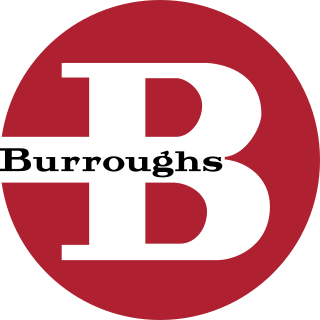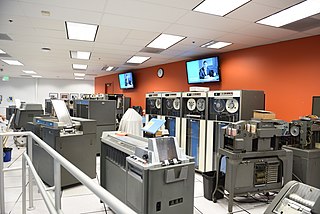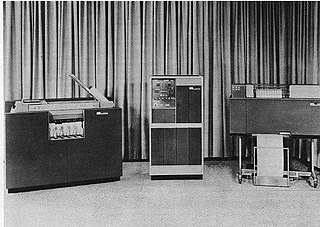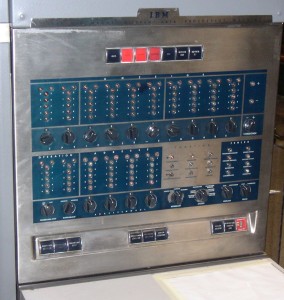Related Research Articles

In computing and electronic systems, binary-coded decimal (BCD) is a class of binary encodings of decimal numbers where each digit is represented by a fixed number of bits, usually four or eight. Sometimes, special bit patterns are used for a sign or other indications.

The Burroughs Corporation was a major American manufacturer of business equipment. The company was founded in 1886 as the American Arithmometer Company by William Seward Burroughs. In 1986, it merged with Sperry UNIVAC to form Unisys. The company's history paralleled many of the major developments in computing. At its start, it produced mechanical adding machines, and later moved into programmable ledgers and then computers. It was one of the largest producers of mainframe computers in the world, also producing related equipment including typewriters and printers.
In computer science, an integer is a datum of integral data type, a data type that represents some range of mathematical integers. Integral data types may be of different sizes and may or may not be allowed to contain negative values. Integers are commonly represented in a computer as a group of binary digits (bits). The size of the grouping varies so the set of integer sizes available varies between different types of computers. Computer hardware nearly always provides a way to represent a processor register or memory address as an integer.

In computer programming, machine code is computer code consisting of machine language instructions, which are used to control a computer's central processing unit (CPU). Although decimal computers were once common, the contemporary marketplace is dominated by binary computers; for those computers, machine code is "the binary representation of a computer program which is actually read and interpreted by the computer. A program in machine code consists of a sequence of machine instructions ."
The Honeywell 6000 series computers were rebadged versions of General Electric's 600-series mainframes manufactured by Honeywell International, Inc. from 1970 to 1989. Honeywell acquired the line when it purchased GE's computer division in 1970 and continued to develop them under a variety of names for many years. In 1989, Honeywell sold its computer division to the French company Groupe Bull who continued to market compatible machines.
The GE-600 series was a family of 36-bit mainframe computers originating in the 1960s, built by General Electric (GE). When GE left the mainframe business the line was sold to Honeywell, which built similar systems into the 1990s as the division moved to Groupe Bull and then NEC.

The IBM 1401 is a variable-wordlength decimal computer that was announced by IBM on October 5, 1959. The first member of the highly successful IBM 1400 series, it was aimed at replacing unit record equipment for processing data stored on punched cards and at providing peripheral services for larger computers. The 1401 is considered by IBM to be the Ford Model-T of the computer industry due to its mass appeal. Over 12,000 units were produced and many were leased or resold after they were replaced with newer technology. The 1401 was withdrawn on February 8, 1971.

UNIVAC was a line of electronic digital stored-program computers starting with the products of the Eckert–Mauchly Computer Corporation. Later the name was applied to a division of the Remington Rand company and successor organizations.

The UNIVAC 1100/2200 series is a series of compatible 36-bit computer systems, beginning with the UNIVAC 1107 in 1962, initially made by Sperry Rand. The series continues to be supported today by Unisys Corporation as the ClearPath Dorado Series. The solid-state 1107 model number was in the same sequence as the earlier vacuum-tube computers, but the early computers were not compatible with their solid-state successors.
In computer programming, a bitwise operation operates on a bit string, a bit array or a binary numeral at the level of its individual bits. It is a fast and simple action, basic to the higher-level arithmetic operations and directly supported by the processor. Most bitwise operations are presented as two-operand instructions where the result replaces one of the input operands.
The Burroughs Large Systems Group produced a family of large 48-bit mainframes using stack machine instruction sets with dense syllables. The first machine in the family was the B5000 in 1961, which was optimized for compiling ALGOL 60 programs extremely well, using single-pass compilers. The B5000 evolved into the B5500 and the B5700. Subsequent major redesigns include the B6500/B6700 line and its successors, as well as the separate B8500 line.

The IBM System/3 was an IBM midrange computer introduced in 1969, and marketed until 1985. It was produced by IBM Rochester in Minnesota as a low-end business computer aimed at smaller organizations that still used IBM 1400 series computers or unit record equipment. The first member of what IBM refers to as their "midrange" line, it also introduced the RPG II programming language. It is the first ancestor in the product line whose current version is the IBM i series and includes the highly successful AS/400.

The IBM 1400 series are second-generation (transistor) mid-range business decimal computers that IBM marketed in the early 1960s. The computers were offered to replace tabulating machines like the IBM 407. The 1400-series machines stored information in magnetic cores as variable-length character strings separated on the left by a special bit, called a "wordmark," and on the right by a "record mark." Arithmetic was performed digit-by-digit. Input and output support included punched card, magnetic tape, and high-speed line printers. Disk storage was also available.

In computer architecture, 36-bit integers, memory addresses, or other data units are those that are 36 bits wide. Also, 36-bit central processing unit (CPU) and arithmetic logic unit (ALU) architectures are those that are based on registers, address buses, or data buses of that size. 36-bit computers were popular in the early mainframe computer era from the 1950s through the early 1970s.
The Burroughs B1000 Series was a series of mainframe computers, built by the Burroughs Corporation, and originally introduced in the 1970s with continued software development until 1987. The series consisted of three major generations which were the B1700, B1800, and B1900 series machines. They were also known as the Burroughs Small Systems, by contrast with the Burroughs Large Systems and the Burroughs Medium Systems.
In computing, a word is the natural unit of data used by a particular processor design. A word is a fixed-sized datum handled as a unit by the instruction set or the hardware of the processor. The number of bits or digits in a word is an important characteristic of any specific processor design or computer architecture.

A front panel was used on early electronic computers to display and allow the alteration of the state of the machine's internal registers and memory. The front panel usually consisted of arrays of indicator lamps, digit and symbol displays, toggle switches, dials, and push buttons mounted on a sheet metal face plate. In early machines, CRTs might also be present. Prior to the development of CRT system consoles, many computers such as the IBM 1620 had console typewriters.

A decimal computer is a computer that can represent numbers and addresses in decimal and that provides instructions to operate on those numbers and addresses directly in decimal, without conversion to a pure binary representation. Some also had a variable wordlength, which enabled operations on numbers with a large number of digits.
The PDP-11 architecture is a 16-bit CISC instruction set architecture (ISA) developed by Digital Equipment Corporation (DEC). It is implemented by central processing units (CPUs) and microprocessors used in PDP-11 minicomputers. It was in wide use during the 1970s, but was eventually overshadowed by the more powerful VAX architecture in the 1980s.

The IBM System/360 Model 20 is the smallest member of the IBM System/360 family announced in November 1964. The Model 20 supports only a subset of the System/360 instruction set, with binary numbers limited to 16 bits and no floating point. In later years it would have been classified as a 16-bit minicomputer rather than a mainframe, but the term "minicomputer" was not current, and in any case IBM wanted to emphasize the compatibility of the Model 20 rather than its differences from the rest of the System/360 line. It does, however, have the full System/360 decimal instruction set, that allows for addition, subtraction, product, and dividend of up to 31 decimal digits.
References
- ↑ Gray, George (October 1999). "Burroughs Third-Generation Computers". Unisys History Newsletter. 3 (5). Archived from the original on September 26, 2017.
- ↑ Burroughs B2500 and B3500 Systems Reference Manual (PDF). Burroughs Corporation. October 1969.
- ↑ Burroughs B2500 and B3500 Systems Reference Manual 1969, p. 1-4 (20).
- ↑ "The Structure of the MS-3 S-Machine" (PDF). June 30, 1975.
- ↑ George T. Gray; Ronald Q. Smith (2007). "Against the Current: The Sperry-Burroughs Merger and the Unisys Struggle to Survive 1980-2001". IEEE Annals of the History of Computing . 29 (2): 3–17. doi:10.1109/MAHC.2007.16. S2CID 15187529.
- ↑ 'Unisys Takes $1,200m Charge, Cuts 10,000 More Jobs; A, 2200 Lines Survive, Vs to Go', Computer Business Review, July 23, 1991
- ↑ "V Series Instruction Set" (PDF).